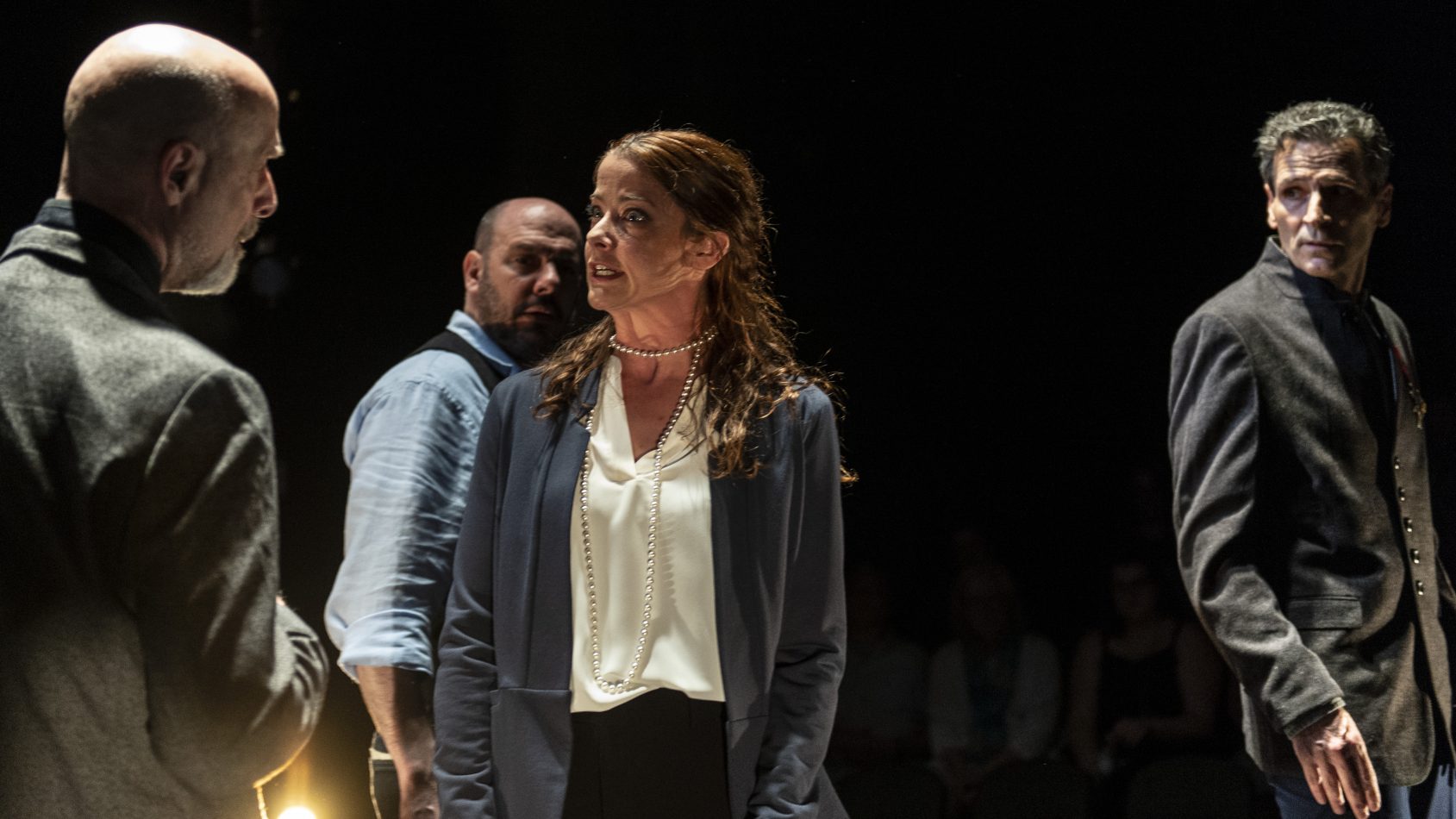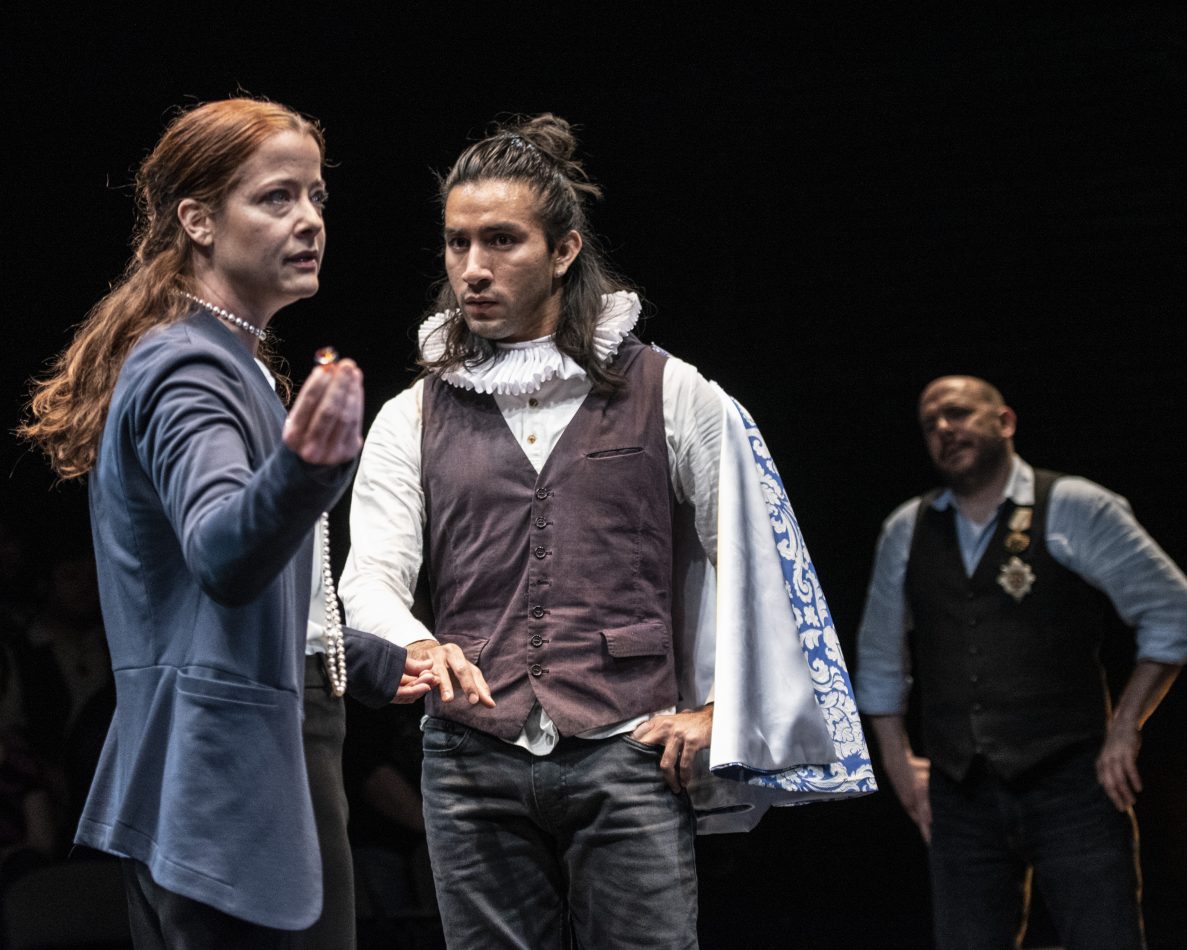It’s an adage modern audiences know very well — especially those with HBO: “When you play the game of thrones, you win, or you die.” In the Elizabethan Era, as Olney Theatre Center’s production of “Mary Stuart” reminds us, the lethal game of thrones was real.
“The story we’re telling at Olney is the sisterhood/rivalry between Elizabeth and Mary,” said Megan Anderson, who plays Queen Elizabeth I in “Mary Stuart,” which is based on a play written in 1800 by the German philosopher-poet Friedrich von Schiller.
That play, “Maria Stuart,” has been adapted by Jason Loewith, Olney Theatre’s artistic director, who adds a contemporary edge with his focus on gender and power issues that continue to resonate today. “Schiller literally focuses on the last few days of Mary’s imprisonment, and the dilemma of Elizabeth — will she or won’t she sign the death warrant? — and the pressure her council puts on her.”
Performed on Loewith’s and set designer Richard Ouellette’s stark Plexiglas turntable of a set by six actors in (mostly) scaled-down costumes by Ivania Stack, “Mary Stuart” is a complex story told in a minimalist way. It’s a historical drama stripped of flourishes and pageantry, which allows its cast to cut to the humanity of its characters.
“I’ve never played a real historical person, certainly not one as iconic as Elizabeth,” said Anderson. “I read as much as I could, just trying to learn about her behavior, the pressures being put on her.”

The Baltimore native, who has appeared on television in “The Wire” and “Veep” as well as in theatrical productions across the D.C. and Baltimore area, said that rather than getting encumbered by the legend of Elizabeth, she decided to channel the legendary “Virgin Queen” and her unique set of circumstances as a powerful woman in a misogynistic age.
“She had a really intense fear of being controlled by men; she had a wicked temper and a really quick wit; she was really smart and worked really hard to maintain her independence,” explained Anderson. “Those are things that, as a human, I can relate to. It’s my job to honor what is written and what we know to be true about her.”
What we know about Elizabeth I of England is that she reigned from November 1558 until her death at age 69 in March 1603. The daughter of King Henry VIII and Anne Boleyn, who was beheaded when Elizabeth was a toddler, Elizabeth ruled with the help of a group of male advisors led by Lord Burleigh, played in “Mary Stuart” by Paul Morella, and including the Earls of Leicester (Chris Genebach) and Shrewsbury (Mitchell Hébert). Jake Lozano rounds out the cast as Mortimer, a Stuart-sympathizing character created by Schiller, and everyone plays other secondary roles.
But the play’s eponymous protagonist is not Elizabeth but her cousin and rival Mary Stuart, better known as Mary Queen of Scots. “She’s been in England — imprisoned, basically — for 19 years,” said Eleasha Gamble, the Takoma Park native who plays Mary Stuart. “At this point she has been put on trial, because there have been all these plots where people are trying to assassinate Elizabeth and put Mary on the throne.”
Eleasha Gamble makes use of the “Mary Stuart” set, a smoked Plexiglas turntable designed by Richard Ouellette and the show’s director Jason Loewith.
Teresa Castracane Photography
By blood, Gamble explained, Mary did have a strong claim to the English throne. The only surviving child of King James of Scotland, Mary became that country’s queen when she was six days old, but spent her childhood in France while regents ruled in her name. The granddaughter of Margaret Tudor, who was Henry VIII’s sister, Mary was perceived to be the true heir to the English throne by many Catholics who considered Elizabeth illegitimate. “She was constantly seen as a threat to Elizabeth,” said Gamble. “People along the way took up her case, trying to get her to assume the throne.”
In 1586, Mary was implicated in a plan to assassinate Elizabeth known as the Babington plot. “They had evidence,” said Gamble. The question is, was it real evidence or was it fabricated? You don’t really know. But it made it seem that Mary was involved, and that was enough to basically put her on trial.”
She was found guilty and sentenced to death — and the bulk of “Mary Stuart” deals with Elizabeth wrestling with her conscience over whether or not to execute her cousin and fellow queen. “It’s a big moral tug of war for Elizabeth because they’re blood relations and sister monarchs,” Gamble observed. “If I believe I am anointed by God to be queen, do I have the right to put another anointed queen to death? There’s a lot of that internal struggle, and it’s up to the audience to decide who’s right and who’s wrong. There’s a lot of ambiguous gray area there. It’s not an easy answer.”
That ambiguity forces comparisons between the world of “Mary Stuart” and contemporary society. “What’s amazing is that you do see these two women who are in power,” Gamble observed. “But they’re ‘in power’ in this male-driven society, the world that we’ve all lived in forever, that has always been ruled by men.”

Watching how Mary and Elizabeth try to operate within that world is part of what makes the play fascinating. “Do you un-sex yourself? Do you find a way to keep your femininity and follow your heart? There’s that line that woman constantly have to figure out: What do we need to be for society, because society always wants to put us into those pigeonholes of what a woman should be,” Gamble said.
“I think it’s very timely,” she added. “We’re definitely in that place in our journey, as women, going, ‘No! We can be more than just these roles that people try to force us into.’ That’s what we’re seeing now, with the Nasty Woman Movement pushing beyond what society keeps telling us we have to be.”
The solidarity and sisterhood of that movement came centuries too late to save Mary Stuart or the conscience, perhaps, of Queen Elizabeth I. But “Mary Stuart” stands as an illustration of the challenges women in power have always faced — as compelling as any game of thrones.
“Mary Stuart” runs through June 9 at Olney Theatre Center’s Mulitz-Gudelsky Theatre Lab, 2001 Olney-Sandy Spring Road, Olney. Regular performances start at 7:45 p.m. Wednesday through Saturday, and 1:45 p.m. Saturday and Sunday. There will be a sign-interpreted performance will be at 7:45 p.m. Thursday, May 30.Tickets begin at $54, with discounts available for groups, seniors, military and students. Call 301-924-3400 or visit www.olneytheatre.org.